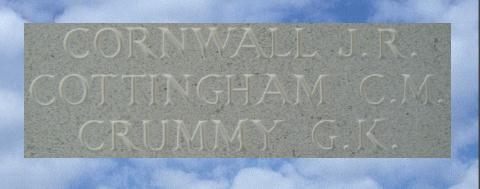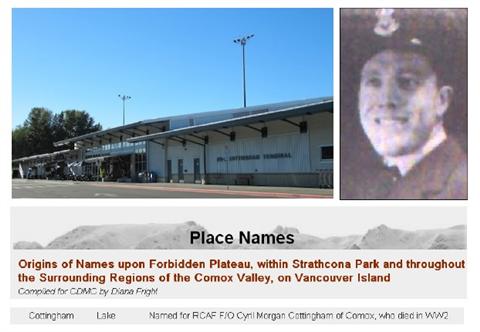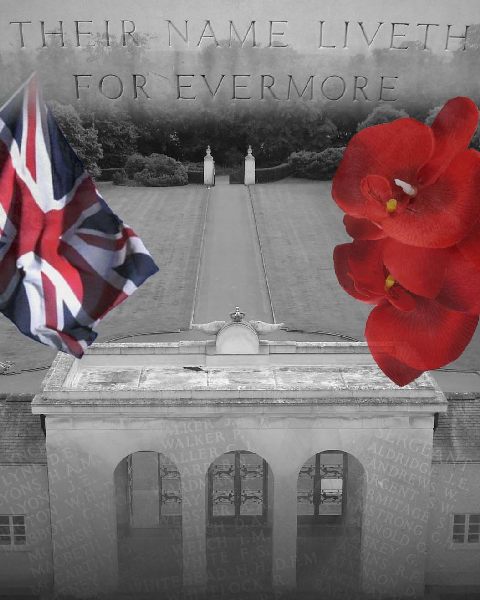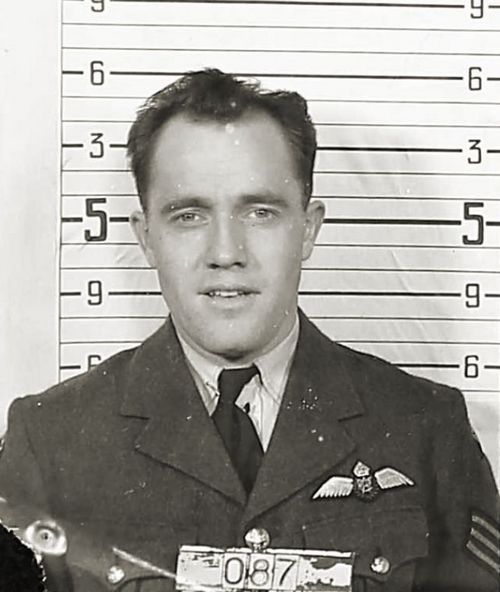Personnel Index - Detail
Photographs courtesy of Michel Beckers from WWII Crashsite Research
From the panel at Runnymede
This airman flew Lancaster ED999 at least once....click for an image and information about this aircraft.
Research by Ashley Hales
9 WING COMOX – Hundreds of people gathered on Friday to witness the Lieutenant Governor of British Columbia, the Honourable Iona Campagnola, open the new F/O Cyril Cottingham Terminal, located on 19 Wing Comox.
On November 22, 1943, Flying Officer Cyril Morgan Cottingham and his crew of six men went missing after an air raid over Germany. It is believed that they went down in the North Sea. They have no known grave, but their names are inscribed on the Runnymede Memorial in Surrey, England. Cyril Morgan Cottingham age 25, the pilot and Captain of the Lancaster aircraft JB 368, was on his 19th mission. He did not win a chest of glorious medals; he did not do any single act of bravery. Like so many Canadian servicemen he "did his duty" and that meant paying the highest price.

22/23 November, 1943; BERLIN:
Berlin had enjoyed only a few nights of peace before receiving its heaviest raid of the war so far. Over 760 bombers set out for the German capital - the majority were Lancasters but 50 Stirlings were making what was to be the type’s last raid into Germany.
With German night-fighters hampered by poor weather conditions on the ground, the bomber force made a virtual straight in and out attack. But despite this tenuous advantage given to the bombers, 26 of their number were still brought down. The total cloud cover did not prevent Berlin receiving an accurate attack which caused vast areas of destruction.
The squadron suffered the loss of yet another experienced crew, that of Canadian pilot F/O Cyril Cottingham. He and his crew are remembered on the Runnymede Memorial along with F/Lt George Bailey, the 2nd pilot; F/Lt Bailey was an American from Connecticut who had volunteered for the RCAF. F/Lt Bailey's own devastated crew were all returned to Swinderby HCU on the 25th November, where they would have to re-learn the ropes with a new skipper.
Missing JB368 (EA-G)
F/O C.M. Cottingham RCAF Pilot (Missing)
Sgt A.J. Mathieson F/E (Missing)
F/O R.B. Richard RCAF NAV (Missing)
Sgt G. Tabenor W/AG (Missing)
Sgt G.F.A.E.J. Falck A/G (Missing)
F/O M.W. Wright B/A (Missing)
F/S C.E. Byers RCAF A/G (Missing)
F/L G.C. Bailey (USA)RCAF 2nd Pilot (Missing)
Crew on their 17th operation
Further information from the BBC website (researched by Ashley Hales)
Canadian airport salutes Welsh hero
An airport terminal in Canada has been named in memory of a Welsh pilot who died during World War II.
Flying Officer Cyril Morgan Cottingham, originally from Aberystwyth, grew up on the island of Vancouver, where the Comox Valley Airport now stands.
The new building - F/O C Cottingham Terminal - was built at the spot where he played as a child.
His family moved to Canada in 1927 at a time when he could not speak a word of English. Cyril's family, who were from Goginan (Wales), emigrated to Canada when he was nine years old, settling down in Lazo, British Columbia.
He joined the local primary school in Comox along with his brother Glyn and sister Doreen but all three experienced difficulties as they could not speak English, only Welsh.
The family eventually settled, but war was approaching and Cyril decided to join the RAF.
He left for Britain in 1942 and flew Lancasters from Fiskerton near Lincoln.
He wrote home during his trip describing England as "old-fashioned."
"I often wonder why so many people would chose to live on such a small island," he wrote.
"But I would like to see more of it. I flew over Wales the other day and marvelled at its beauty."
But in November 1943, tragedy struck when he and his crew of six lost their lives over the North Sea during a war mission.
The terminal, which was officially opened on 16 April 2004, has been named in memory of him and the countless other young men from Comox who lost their lives serving their country.

